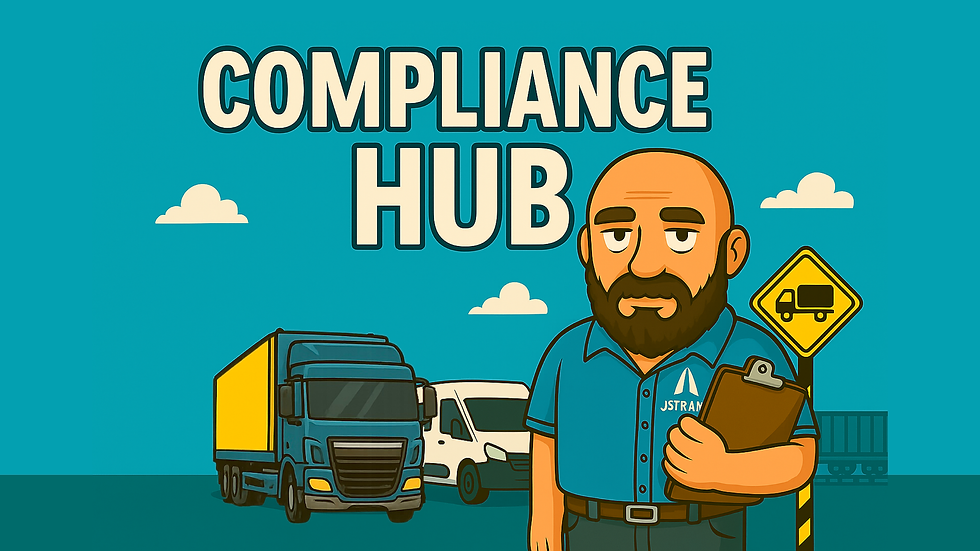How Long Should You Keep Transport Records? A Quick Reference Guide
- stuart47304
- Jul 8
- 4 min read

Whether you operate a single 7.5-tonne vehicle or a small fleet of rigids, keeping the right transport records — and holding onto them for the correct amount of time — is essential to staying compliant with your Restricted Operator Licence.
But how long is long enough? And what can you safely dispose of without risking trouble from the DVSA or Traffic Commissioner?
This guide gives you clear, quick-reference answers on:
Minimum legal retention periods
What to keep permanently
Smart ways to stay organised
Paper vs digital considerations
Best practice tips for inspections and audits
Let’s make record-keeping one less thing to worry about.
Why Record Retention Matters
You’re legally required to keep certain records relating to your vehicles, drivers, and licence — to prove your operation is safe, compliant, and well managed.
Poor or missing records are one of the biggest red flags during DVSA inspections, and often lead to:
Vehicle prohibitions
Fixed penalties
Licence curtailment or revocation
Unfavourable findings at Public Inquiry
Having a clear retention policy keeps you on the right side of the law — and makes your life easier when the DVSA comes calling.
Quick-Reference Record Retention Table
Record Type | Minimum Retention Period |
PMI (safety inspection) reports | 15 months |
Defect reports / Daily walkaround checks | 15 months |
Repair and maintenance records | 15 months |
Brake test reports | 15 months |
MOT test certificates | 15 months |
Tachograph calibration certificates | Until superseded (next calibration) |
Driver licence checks | 15 months (recommended) |
Working time / driver hours records | 2 years |
Tachograph data (driver cards) | 12 months |
Tachograph data (vehicle units) | 12 months |
Transport policy documents | While current + 12 months |
Operating centre permission letters | While site in use |
Maintenance contracts / service agreements | While in force + 12 months |
Financial standing evidence | Until replaced or updated |
Public Inquiry correspondence | Permanently |
Operator Licence certificates | While valid |
Insurance documents (motor and liability) | 6 years (for HMRC/legal) |
Employee contracts or driver agreements | 6 years after termination (HMRC best practice) |
Key Legal Requirements (Summarised)
🔧 Maintenance & Inspection
The DVSA requires 15 months of records for:
PMIs
Repairs
Brake tests
Daily walkaround checks
MOT certificates
These must be readily available and clearly linked to individual vehicles and trailers.
⏱️ Driver Hours & Working Time
You must keep:
Tachograph data: minimum 12 months
Working time records: at least 2 years (if applicable)
Download logs and infringement reports: also 12–24 months recommended
📄 Licence & Compliance Docs
Keep your Operator Licence certificate and any variations permanently
Retain Public Inquiry paperwork, audit reports and Traffic Commissioner letters indefinitely
Keep proof of financial standing until your licence is surrendered or updated
Best Practice: Keep Some Records Longer Than the Minimum
While the legal requirement is 15 months for most documents, it’s often wise to keep records for up to 3–6 years, especially for:
Claims defence
Legal disputes
Tax purposes (HMRC requires some records for 6 years)
Public Inquiries where historical trends are reviewed
If you’ve had compliance issues before, holding longer records shows a consistent commitment to improvement.
Paper vs Digital: Does It Affect Retention?
No — DVSA accepts both formats as long as the records are:
✅ Legible
✅ Organised
✅ Accessible within 10 minutes
✅ Traceable to vehicle, driver, and date
Digital records must be backed up and secured. Paper records must be well filed and protected from damage.
Tip: Store backup digital copies even if you use paper, just in case of fire, loss or wear-and-tear.
Tips for Creating a Record Retention Policy
✅ Use a clear folder structure (digital or physical)
✅ Label files by vehicle registration or driver name
✅ Apply auto-archiving rules to cloud systems
✅ Set calendar reminders to archive or review record folders every 6 months
✅ Document your policy so it can be shown at inspection if required
Example:
“JS Transport Solutions retains PMI, defect and MOT records for 3 years, driver records for 2 years, and licence documentation permanently. A review is conducted every January and July.”
What Happens If You Keep Records Too Long?
While not illegal, over-retention can cause:
Confusion during audits (“which version is correct?”)
Breach of data protection (if driver personal info is involved)
Clutter, wasted space and file duplication
Set clear review and purge dates to balance compliance with efficiency.
What If You’re Unsure?
If in doubt:
Keep the record for at least 15 months
If it relates to safety or compliance → 3 years is a safe default
If linked to legal or financial claims → 6 years
You’re better off keeping a record too long than discarding it too early.
Conclusion
Knowing what records to keep — and for how long — is a small but powerful way to stay compliant, avoid fines, and stay ready for inspection.
Use the 15-month rule as your baseline, but be strategic and consistent. The more organised your system, the easier it will be to prove you’re in control of your operation.
Next in the series:👉 Digital vs Paper Records: What’s Best for Small Fleet Operators?
